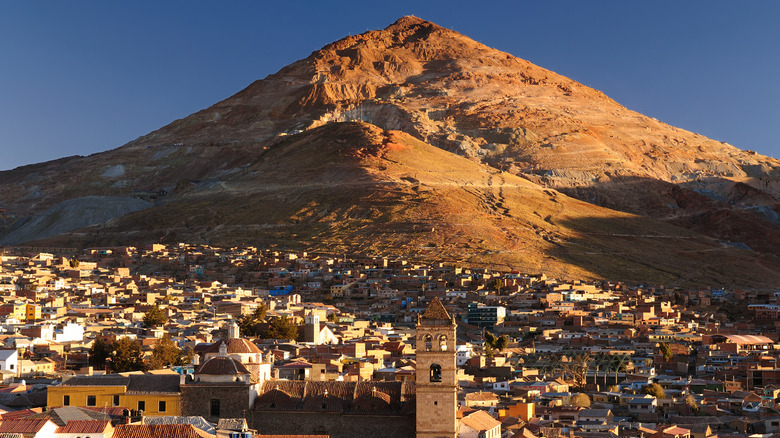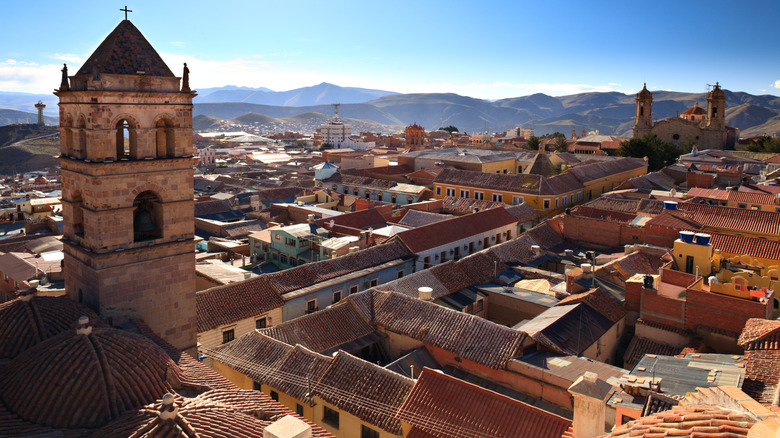An Active Mine Site Is The Main Tourist Attraction In This Dark Tourism Destination In Bolivia
At its 16th and 17th century zenith, Potosí, Bolivia was one of the richest cities on earth. Its population outstripped Europe's imperial capitals, ten times the size of Boston when the first British colonies in North America were beginning to flourish. These new residents arrived with greedy eyes turned to the Cerro Rico, the vast mountain that crowns the Potosí skyline.
Streams of silver once ran across the surface of the Cerro Rico like a web of veins across a chest, a complex undercurrent of unfathomable wealth. Thousands of mining tunnels were burrowed into its rust-colored crag, with treasure hunters plundering its depths for their slice of its exorbitant wealth. Supplying 60% of all the world's silver in its richest age, it was said its innards could build a bridge of solid silver from Bolivia to Madrid. The city's ostentatious colonial shield read: "I am rich Potosí, treasure of the world, king of the mountains, envy of kings."
The Spanish colonialists built 36 resplendent churches in the vertiginous city. Alongside once grandiose homes and sweeping plazas, they are all that remain of Potosí's splendorous past. Travelers in the Bolivian city today will find a deprived city, ravaged by the greed of its colonial predecessors. It's one of the poorest regions in the second most poverty-stricken country in all of South America.
Another thing that tourists will find is travel companies touting tours into the depths of the mines. These excursions include activities like chucking dynamite into a site that swallowed some 8 million souls — enslaved Africans and Indigenous Bolivians forced laborers. And visiting the workers still suffering in heinous conditions, resigned to reaping the last of the dregs from "the mountain that eats men." It's a harrowing place tourists love to visit — but should they?
What are the Potosí mine tours, and should you take one?
Burrowing into the bowels of the Cerro Rico, tours take travelers into the mine shafts left in the wake of Bolivia's imperial epoch. Despite Bolivia being home to some of the world's most outrageous landscapes, and attractions like the steep Death Road, a thrill-seekers magnet, many travelers still undertake Potosí's macabre excursion.
Arguably the city's most popular tourist attraction this "dark tourism" trip leads into the bowels of the Potosí mines. After strapping on lamp-lit hard hats and signing a disclaimer about the risk of being trapped by falling rocks, groups descend into the pitch-black tunnels. They scramble through the slender shafts and cough out the wafting dust, as workers hack at the tin, zinc, and lead deposits lingering in the Cerro Rico.
Their highlights include visiting the altar of El Tío, Potosí's folkloric lord of the underworld. Here, miners pay homage to the demonic deity, distinguished by his horns and goat-like characteristics, the only menacing idol that can grant daily salvation in a place abandoned by the gods. Visitors can leave gifts of 90-proof alcohol and cigarette packs, before setting off sticks of dynamite. Watching their explosions are posited as a fun add-on activity.
While the tour may seem entertaining to some, the ethics are murky. The life expectancy for the miners you'll meet inside is only 40 years old, irreparably impaired by the toxic dust. They earn 150 BOB, or $22 USD, a day. Taking a voyeuristic day trip into their heinous workplaces can leave travelers unsettled. That's exacerbated by the fact that the dynamite dropped is detonated atop mass graves. It's an educational experience, but one that many visitors feel is disrespectful to the beleaguered people of Potosí.
What you should do on a visit to Potosí, Bolivia, instead of a mine tour
In Bolivia, the ruins of empires past don't resemble crumbling Greco-Roman columns or mysterious pyramids to rival ancient Egypt's. Its imperial legacy lies in the partially collapsed peak of its emblematic mountain. However, the silver pillagers that wrought ruin upon the Cerro Rico left their mark on the city, too. Visiting the lingering attractions, you can learn about turbulent history without having to cram into a subterranean shaft.
Soak in the once splendorous city at Plaza 10 de Noviembre, a sweeping square surrounded by colonial architecture. Once a popular spot for bullfights, the plaza now hosts vendors selling traditional snacks and annual carnival celebrations. The neoclassical façade of the city's main cathedral oversees the hubbub of the plaza — you can climb its looming bell tower for panoramic views over the city, or explore sumptuous interiors that have stood in this spot since the 16th century.
Follow up with a visit to another of the plaza's famous structures, the Casa Real de la Moneda. This fortified former royal mint spans across an entire city block, a mighty institution once responsible for crafting the world's first international currency: the potosí coin. These days, it's a museum. Tour its storied halls to see the coins and machinery used in the city's heyday, as well as evocative Bolivian artwork.
While in town, you should also sample a regional delicacy. Potosí's cuisine scene is best known for its k'alapurka soup, a spicy broth of maize and meat that's served with a volcanic rock. Placed directly into the bowl, this eccentric addition causes the soup to emit a steam redolent of Bolivia's geological marvels.


